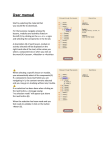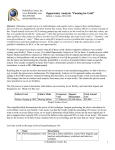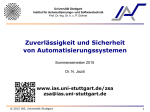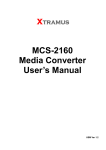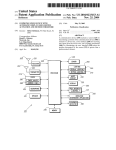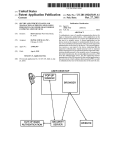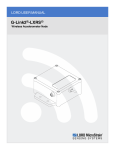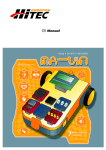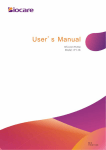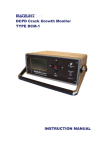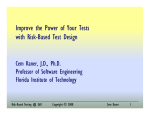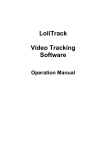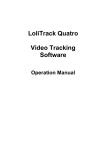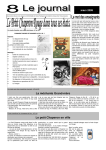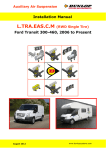Download How Reliable is Your Product?
Transcript
A p p e n d i x D Glossary of Terms Accelerated Life Test (ALT)—The process of determining the useful life of a product in a short period of time by accelerating the use environment (how the product will be used). Acceleration Factor—Denotes how much you are accelerating the test over the end use conditions. Activation Energy—The minimum energy required to start a chemical reaction (a chemical reaction is when a substance changes into another substance). Alpha Risk ( α)—Sometimes referred to as a Type I Error, is the producer's risk, or the risk that you won't ship a good product because the data indicated that the good sample was bad. In other words, is the risk of rejecting the hypothesis that the mean hadn't changed when it hadn't. Analysis of Variance (ANOVA)—Estimation of fractional contributions and error variance. Annualized Failure Rate—The rate at which a product will fail, calculated on a yearly basis. Arrhenius Model—Describes how component reliability is adversely affected as the temperature increases. Availability—The probability a system is ready for use when needed or the proportion of time a system is ready for use. Benchmarking—The process of determining and comparing reliability related metrics for a set of specific products in a specific market. The purpose of Benchmarking is to gain a clear understanding of reliability strengths and weaknesses of competitors' products in your market. How Reliable is Your Product? 50 Ways to Improve Product Reliability 307 Beta Parameter ( β )—The slope of the Weibull Distribution ( β ). Beta Risk ( β )—Sometimes referred to as a Type II Error, is the consumer's risk, or the risk that you will ship a defective product because the data indicated that the failed sample actually is good. In other words, is the risk of accepting the hypothesis that the mean hadn't changed when it had. Black Box Testing—Functional testing based on requirements with no knowledge of the internal program structure or data. Boundary Interface Diagram—A diagram used as part of a brainstorming exercise often used during FMEA. It is useful when you have a complex system or if your system has interfaces with other systems. In the diagram, draw lines showing the interfaces between the different systems. The interfaces can either be physical, energy, material, or data. Burn-In—A form of ESS, running a system at elevated temperature to take advantage of heat as an accelerant. The key variables are the burn-in temperature and the amount of burn-in time. Certified Reliability Engineer (CRE)—The American Society for Quality has a program to become a Certified Reliability Engineer, CRE. Certification is based on education, experience, and a certification test; periodic recertification is required. The body of knowledge for the test includes: reliability management, design evaluation, product safety, statistical tools, design and development, modeling, reliability testing, collecting and using data, etc.8 Closed Loop Corrective Action (CLCA)—To identify, analyze, and correct a problem with a product or process. Coffin-Manson Model—A model used to describe mechanical fatigue in material and crack growth in solder and other metals due to repeated temperature cycling. Cold Operating Limit (COL)—During HALT, when stepping the temperature down, the lower temperature limit below which the product ceases to function. Commercial-Off-The-Shelf (COTS)—Commercially available hardware. This is often used with military and space systems in which military or space grade hardware is too costly or not available or both. Note that COTS does not necessarily mean commercial quality. 8. "Certified Reliability Engineer" (2010). Wikipedia. [Online]. http://en.wikipedia.org/wiki/Certified Reliability Engineer 308 Appendix D: Glossary of Terms Competitive Analysis—Process by which you compare your product's reliability performance to competitive products. Use the results as input to your Gap Analysis to determine appropriate next steps to improve your organization's reliability program. The two main types of Competitive Analyses are Competitive HALT and Competitive Teardown Analysis. Competitive HALT—Subject two or more products to HALT up to their operational/destruct limits and then compare the product margins. With similar technologies, a product that has better margins is generally a more reliable product. Competitive Teardown Analysis—Compare two or more products by disassembling each and then comparing a number of different attributes. The two key elements to this process are to 1. develop a meaningful set of attributes, and 2. develop an objective scoring system for each attribute. Component Counterfeiting—Process by which a third-party company tries to copy the design of another company. The counterfeit component could have a whole range of issues from having parameters that don't meet the specifications of the genuine component, all the way to a complete empty package that has no functionality at all. Component Parameter—Testing When the situation arises in which your supplier can't or won't guarantee component parameters, then you should write a custom specification for the product and test those specific parameters on an ongoing basis, either using a sampling plan or 100% testing. Component Selection—The purpose of selecting the appropriate components for the particular application and environment is to optimize reliability versus cost in the given use environment. Most designs have a few components that account for the majority of reliability or quality issues, and it is these few components that you should analyze in more detail during the design to mitigate these issues before they occur. Computational Fluid Dynamics (CFD)—One of the branches of fluid mechanics that uses numerical methods and algorithms to solve and analyze problems that involve fluid flows.9 9. "Computational Fluid Dynamics" (2010). Wikipedia. [Online]. http://en.wikipedia.org/wiki/Computational Fluid Dynamics How Reliable is Your Product? 50 Ways to Improve Product Reliability 309 Computer Aided Design (CAD)—The use of computer technology for the process of design and design-documentation.10 Conductive Anodic Filament (CAF)—A form of electrochemical metal migration or dendritic growth between two conductors within a printed circuit board (PCB).11 Confidence Interval—A particular kind of interval estimate of a population parameter. Instead of estimating the parameter by a single value, an interval likely to include the parameter is given. Thus, confidence intervals are used to indicate the reliability of an estimate. How likely the interval is to contain the parameter is determined by the confidence level or confidence coefficient. Increasing the desired confidence level will widen the confidence interval.12 Confidence Level—A confidence interval is always qualified by a particular confidence level, usually expressed as a percentage.13 Confidence Limits—The end points of the confidence interval.14 Consumer's Risk—See Beta risk ( β ). Contract Manufacturer (CM)—A company that specializes in manufacturing products for other companies. Control Factor—In an experiment, these are all of the factors that you have the ability to change. Corrective Action—See Closed Loop Corrective Action (CLCA). Corrective and Preventative Action (CAPA)—See Closed Loop Corrective Action (CLCA). Corrosion—Deterioration of metals caused by oxidation or chemical action. 10. "Computer Aided Design" (2010). Wikipedia. [Online]. http://en.wikipedia.org/wiki/Computer_Aided_Design 11. "Conductive Anodic Filament" (2010). Wikipedia. [Online]. http://en.wikipedia.org/wiki/Conductive_Anodic_Filament 12. "Confidence Interval" (2010). Wikipedia. [Online]. http://en.wikipedia.org/wiki/Confidence_Interval 13. "Confidence Level" (2010). Wikipedia. [Online]. http://en.wikipedia.org/wiki/Confidence_Level 14. "Confidence Limits" (2010). Wikipedia. [Online]. http://en.wikipedia.org/wiki/Confidence_Limits 310 Appendix D: Glossary of Terms Cosmic Rays—Particles coming from outside the solar system. These particles can interact with electronics and cause temporary upsets in performance. Creep Degradation—The loss of property or breakdown of a material due to overexposure to heat. Critical to Quality (CTQ)—Specific, measurable characteristics of a product or process that are necessary for your customers' satisfaction. Cross-Sectioning—In the context of failure analysis, this is the process of grinding of die and package, usually perpendicular to the surface of the die, to examine defects. Cumulative Distribution Function (CDF)—Describes the probability that a real-valued random variable X with a given probability distribution will be found at a value less than x. Intuitively, it is the "area so far" function of the probability distribution.15 Customer-Specified Goals—When your customers specify the reliability requirements for your product. Mean time between failure (MTBF), mean time to repair (MTTR), availability, dead on arrival (DOA) rate, and return rate are common reliability goals, but there are many others. Date Code—Product build dates that vendors stamp onto their product. These date codes can be very useful if you discover a failure on the manufacturing line or in the field that may be related to a particular date range of when the product was created. Dead on Arrival (DOA)—The rate of products that don't work when your customer first receives and installs the product. Decapsulation—During failure analysis, the process of removing the cover of a semiconductor package. Defect Insertion Rate—The rate at which you introduce new defects to a software process. Dendrite Growth—A type of failure that is caused by grain development that resembles the increasingly smaller branches of a tree. 15. "Cumulative Distribution Function" (2010). Wikipedia. [Online]. http://en.wikipedia.org/wiki/Cumulative_Distribution_Function How Reliable is Your Product? 50 Ways to Improve Product Reliability 311 Derating Analysis—The practice of operating at a lower stress condition than the rating specified for a component. Design FMEA—FMEAs performed on the system at the design level. The purpose is to analyze how failure modes affect the system, and to minimize failure effects upon the system. Design for Maintainability—Part of the DfX (Design for Excellence) methodology, in which you consider during the design phase the preventive maintenance and repair of your product. Design for Manufacturability (DFM)—Part of the DfX (Design for Excellence) methodology in which you consider during the design phase how your manufacturing team or partner will assemble and build your product. Design for Reliability (DFR)—Part of the DfX (Design for Excellence) methodology in which you consider during the design phase how to optimize the reliability of your product. Design for Warranty—Part of the DfX (Design for Excellence) methodology in which you consider during the design phase how to optimize your warranty period (set the warranty rate for your product to minimize the number of products that fail within your product's warranty period while maximizing the length of warranty you can offer). Design Margin—See Operating Margin. Design of Experiments (DOE)—An experiment which can focus on a wide range of key input factors or variables and will determine the optimum levels of each of the factors. Destruct Limit—In HALT, a limit in which the failure doesn't recover when you reduce or remove the stress. Detection (D)—In an FMEA, a score that indicates the ability to detect a failure if it does occur. Detection Shift Level—The shift in percentage from your current production failure rate to a new production failure rate due to a process change. In most cases, you can't detect this shift immediately, resulting in shipping product at this higher failure rate for a period of time until you can detect this shift. The lower the detection shift value, the more samples you must test before you discover this change. 312 Appendix D: Glossary of Terms Dielectric Breakdown—The complete failure of a dielectric material that is characterized by a disruptive electrical discharge through the material that is due to deterioration of material or to an excessive sudden increase in applied voltage. Duty Cycle—The percentage of time a product is operated compared to the total calendar time. Early Reliability Testing (ERT)—A development strategy that can provide higher reliability and quality, with less cost and time for development, as well as less development risk. Electrical Overstress (EOS)—An unusual spike in voltage applied to the system that causes damage (usually at the component level), resulting in a failure. Some signs of EOS are blown metal line or molten damage. Electrostatic Discharge (ESD) is a subset of EOS. Electromagnetic Interference (EMI)—Disturbance that affects an electrical circuit due to either electromagnetic conduction or electromagnetic radiation emitted from an external source. The disturbance may interrupt, obstruct, or otherwise degrade or limit the effective performance of the circuit. The source may be any object, artificial or natural, that carries rapidly changing electrical currents, such as an electrical circuit, the Sun or the Northern Lights.16 Electromigration—High current density that can move atoms out of the active regions, leading to emergence of dislocations and point defects, acting as nonradiative recombination centers and producing heat instead of light.17 Electron Microscope (EM)—Type of microscope that produces an electronically-magnified image of a specimen for detailed observation. The EM uses a particle beam of electrons to illuminate the specimen and create a magnified image of it. It has a greater resolving power than a light-powered optical microscope, because it uses electrons that have wavelengths about 100,000 times shorter than visible light (photons), and can achieve magnifications of up to 2,000,000x, whereas light microscopes are limited to 2000x magnification.18 16. "Electromagnetic Interference" (2010). Wikipedia. [Online]. http://en.wikipedia.org/wiki/Electromagnetic_Interference 17. "Electromigration" (2010). Wikipedia. [Online]. http://en.wikipedia.org/wiki/Electromigration 18. "Electron Microscope" (2010). Wikipedia. [Online]. http://en.wikipedia.org/wiki/Electron_Microscope How Reliable is Your Product? 50 Ways to Improve Product Reliability 313 Electronic Design Automation (EDA)—A category of software tools for designing electronic systems, such as printed circuit boards and integrated circuits.19 Electronic Manufacturing Service (EMS)—See Contract Manufacturer (CM). Electrostatic Discharge (ESD)—The release of static electricity when two objects come into contact. Typically this is when a person has a build-up of charge, comes in contact with electronics, and causes a discharge event, transferring the charge to the electronics. End-of-Life (EOL)—Analysis An estimate of the onset of wear-out failures for consumables (e.g., electrolytic capacitors, fans, motors, drives). An EOL Analysis can aid in planning warranty costs and scheduling Preventive Maintenance (PM). Engineering Change Order (ECO)—A system by which you make a change to your product, including all of the documentation involved. Environmental Stress Screening (ESS)—The process of applying external stresses to a manufacturing sample of a product (usually temperature and/or vibration) to accelerate time in order to expose any manufacturing defects before shipping the sample to a customer. HASS, Run-In, and Burn-In are types of ESS. Evolutionary Product—A product that is similar to a previous generation but with modifications for new features. Expert Reliability—Review When a senior engineer (expert) reviews the work of an engineer or junior engineer. Exponential Distribution—A continuous probability distribution that describes the times between events in a Poisson process, i.e., a process in which events occur continuously and independently at a constant average rate.20 Extended Warranty—A warranty contract that you can purchase to increase the amount of time a product is covered under the manufacturer's warranty period. 19. "Electronic Design Automation" (2010). Wikipedia. [Online]. http://en.wikipedia.org/wiki/Electronic_Design_Automation 20. "Exponential Distribution" (2010). Wikipedia. [Online]. http://en.wikipedia.org/wiki/Exponential_Distribution 314 Appendix D: Glossary of Terms Facilitation—The process of designing and running a successful and impartial meeting. Facilitation services the needs of any group who is meeting with a common purpose, whether it be making a decision, solving a problem, or simply exchanging ideas and information.21 Facilitation of Code Reliability Review—The use of reliability reviews to target the core and vulnerable sections of code to allow the owner of the source code to develop sufficient synergy with a small team of developers in finding defects. Facilitation of Team Design Review—Conducting brief, informal reviews that are highly interactive at multiple points throughout the progression, from system architecture all the way to low-level design. Facilitation of Team Design Template Review—Conducting group pre-design review meetings to provide your team with forums to expand their knowledge base of design techniques by exchanging design templates. Failure Mechanism—The cause of the failure mode such as "corrosion" or "vibration." Failure Mode—The actual symptom of the failure, such as "failed component" or "degradation of performance." Failure Modes and Effects Analysis (FMEA)—A systematic method of identifying and preventing product and process problems before they occur. Failure Modes, Effects, and Criticality Analysis (FMECA)—Similar to an FMEA with the "C" standing for criticality. The process is the same except now you capture one more score—the criticality of the failure. See MIL-HDBK-1629 for a more detailed explanation on the term criticality. Failure Reporting Analysis and Corrective (FRACAS)—See Closed Loop Corrective Action (CLCA). Action System Failure Review Board (FRB)—A team assigned to a company to review each failure and determine its disposition. Fatigue—The effects of dynamic loading causing a loss in strength of a material. 21. "Facilitation" (2010). Wikipedia. [Online]. http://en.wikipedia.org/wiki/Facilitation How Reliable is Your Product? 50 Ways to Improve Product Reliability 315 Fault Tree Analysis (FTA)—A systematic, deductive method for defining a single specific undesirable event and determining all possible failures that could cause the event in question to occur. A top-down approach to failure mode analysis. Field Data Tracking—The process of collecting product performance data from the field and analyzing it using statistics to determine trends and to measure your reliability against your original goals. Field Failure Rate—The rate at which a product fails in the field. This is usually expressed as a percentage. Finite Element Analysis (FEA)—A technique to estimate the responses of structures and materials to environmental factors such as fluid flow, forces, heat, and vibration. With complex mechanical components, it is possible to model these factors by subdividing a component down into small, "finite" elements, and to analyze the component as an assembly of these small, simple elements. First Pass Yield—The percentage of samples that pass the testing process the first time through without requiring any rework. First Year Multiplier (FYM)—A factor applied to a reliability prediction for the increased failure rate due to manufacturing imperfections. Fourier Transform Infrared Spectroscopy (FTIR)—Technique which is used to obtain an infrared spectrum of absorption, emission, or photoconductivity of a solid, liquid or gas. An FTIR spectrometer simultaneously collects spectral data in a wide spectral range. Fracture Mechanics—Field of mechanics concerned with the study of the formation of cracks in materials. It uses methods of analytical solid mechanics to calculate the driving force on a crack and those of experimental solid mechanics to characterize the material's resistance to fracture.22 Fretting—Wear and sometimes corrosion damage at the edges of contact surfaces. This damage is induced and in the presence of repeated relative surface motion, as induced for example by vibration.23 22. "Fracture Mechanics" (2010). Wikipedia. [Online]. http://en.wikipedia.org/wiki/Fracture_Mechanics 23. "Fretting" (2010). Wikipedia. [Online]. http://en.wikipedia.org/wiki/Fretting 316 Appendix D: Glossary of Terms Functional Testing—The method of testing a product to ensure it is performing its intended functions. When performing a reliability test, it is usually important to functionally test the product at all times. Fundamental Limit of the Technology (FLT)—The limit at which you can't go any higher with a stress without changing the failure mechanism and producing nonrelevant failures. Gap Analysis—The process of determining the spread between your reliability goals and your current capabilities. Goal Setting—The process of setting targeted goals at the beginning of a design/development program and then putting forth a plan to achieve the goals. Golden Nuggets—Those few techniques that your team does well and recognizes they do them well so these become engrained into your culture. Grms—Gravity Root Mean Squared. A unit of measure for vibration in which you calculate the total amount of the vibration under a Power Spectral Density (PSD) curve within a band of frequencies. Guard Band Limits—During a HALT, a guideline as to the limits you meet as a minimum. HALT-to-AFR Calculator—A mathematical model that, when provided with the appropriate HALT and product information, will accurately estimate a product's actual failure rate (AFR) in the field. Highly Accelerated Life Test (HALT)—A design technique that you can use to discover product weaknesses and design margins. The intent is to subject a product systematically to stress stimuli well beyond the expected field environments in order to determine the operating and destruct limits of your product. Highly Accelerated Life Test (HALT) Plan—The plan by which you document the information on the types of stresses, levels of stresses, and order of stresses. You should also determine the number of samples, functional tests, what parameters to monitor, and what constitutes a failure. Decisions in this plan will dictate the relative success of the HALT. Highly Accelerated Life Test (HALT) Report—The report by which you document all of your findings in HALT (including at what point each failure occurred and what steps you took to work around each failure). Pictures, charts, and graphs are great for your management. However, the most important parts of the report are your recommendations and the follow-up actions you plan to take. How Reliable is Your Product? 50 Ways to Improve Product Reliability 317 Highly Accelerated Stress Audit (HASA)—Similar to HASS, except that you will screen only a portion of the product (called an audit) rather than 100% as in HASS. As with any audit, you will need to set up criteria for when to decrease the sample size and when to increase the sample size, mostly based on the results of the audit. Highly Accelerated Stress Audit (HASA) Plan—The plan that documents how to move from 100% HASS to a HASS audit, also known as HASA. When writing the plan, make sure to describe what criteria need to be met in order to move to HASA. The two key criteria that you need to satisfy before switching from HASS to HASA are: 1. The defect rate must be at its target, and 2. The process must be stable. In the plan, decide on the following parameters: detection shift level, alpha risk and beta risk levels, and sample size. Highly Accelerated Stress Screening (HASS)—A process comprising a set of stresses performed on a product before it is shipped with the goal of finding manufacturing related defects. The set of stresses combined together make up the screen. Highly Accelerated Stress Screen (HASS) Plan—The plan that documents the HASS process from start to finish, including choosing the stress types, developing the screen profile, the equipment trade-off analysis, fixture design, POS, HASS implementation strategy, and the trend analysis. The plan will serve as your roadmap and you can use it as a decision tool during the implementation process. Hot Carrier Injection—Phenomenon in solid-state or semiconductor electronic devices where either an electron or a "hole" gains sufficient kinetic energy to overcome a potential barrier necessary to break an interface state.24 Hot Operating Limit (HOL)—During HALT, when stepping the temperature up, the upper temperature limit above which the product ceases to function. Human Factors Analysis—The study of all aspects of the way humans relate to the equipment, with the aim of improving operational performance, reliability, and safety. 24. "Hot Carrier Injection" (2010). Wikipedia. [Online]. http://en.wikipedia.org/wiki/Hot_Carrier_Injection 318 Appendix D: Glossary of Terms Infant Mortality—The period of a product life cycle in which the failure rate is decreasing in rate over time. Failures in this period of time are typically due to a manufacturing defect. Infant Mortality Region—The region of decreasing slope or decreasing failure rate from time t=0 and forward. Typically the probability of failure is highest immediately after you ship the product to your customer and then after that point, the failure rate reduces. Input (in reference to DOE)—These are the entries into the system from another device or from a user (such as a user interfacing with the system). Internally-Specified Goals—Goals that come from within your company rather than from external competition. These goals are usually based on trying to be better than previous products. One of the executives of a company may put forth some sort of edict such as "our next product will have half the field returns than our previous product." You can then take this and turn it into a goal statement. Ion Chromatography—Process that allows the separation of ions and polar molecules based on their charge.25 Latent Defect Density—The number of defects per lines of code still remaining in the software after you start shipping the software. Leading Indicator—An ALT that is run not to the point of a failure but rather until you detect an indication that a parameter has changed. First you should determine what parameter(s) you should monitor and then you should run a calibration step in order to be able to properly extrapolate the failure. Lessons Learned—The process of capturing all of the issues that occur in a program in a centralized system for all personnel to share, and then reviewing these issues prior to embarking on a new design. Life Cycle Cost (LCC)—Refers to the total cost of ownership over the life of a product. Also commonly referred to as "cradle to grave" or "womb to tomb" costs.26 25. "Ion Chromatography" (2010). Wikipedia. [Online]. http://en.wikipedia.org/wiki/Ion_Chromatography 26. "Life Cycle Cost" (2010). Wikipedia. [Online]. http://en.wikipedia.org/wiki/Life_Cycle_Cost How Reliable is Your Product? 50 Ways to Improve Product Reliability 319 Log-Log Graph—A graph drawn on paper with logarithmic horizontal axis and logarithmic vertical axis. Log-Normal Distribution—A probability distribution of a random variable whose logarithm is normally distributed. A variable might be modeled as log-normal if it can be thought of as the multiplicative product of many independent random variables each of which is positive. Maintainability Analysis—The method of determining how to best design a product for ease of maintenance. Maintainability Prediction—The method of determining how long it takes to repair a product once it fails. Manufacturing Screen—The method of stressing a product either electrically or environmentally to accelerate time during manufacturing with the goal of uncoving latent manufacturing defects that would otherwise escape and then soon fail after your customer starts using the product. Markov Analysis—Process of analyzing the reliability and availability of systems whose components exhibit strong dependencies. Mean Square Deviation—Measure of the differences between values predicted by a model or an estimator and the values actually observed from the thing being modeled or estimated.27 Mean Time Between Failure (MTBF)—Predicted elapsed time between inherent failures of a system during operation. It is the inverse of the failure rate.28 Mean Time to Repair (MTTR)—The average time to repair a product and get it operational after it fails. Memory Leak—When software routines use up a portion of memory after they load a program and then don't give the memory back after they close the program This causes the available memory to shrink, which in turn results in the product slowing down (because the processor must spend more time looking for available memory). 27. "Mean Square Deviation" (2010). Wikipedia. [Online]. http://en.wikipedia.org/wiki/Mean_Square_Deviation 28. "Mean Time Between Failure" (2010). Wikipedia. [Online]. http://en.wikipedia.org/wiki/Mean_Time_Between_Failure 320 Appendix D: Glossary of Terms MIL217G—An effort being developed by the VITA 51 Working Group to investigate the state of the Reliability Prediction industry and develop a method to address electronics failure rate prediction issues. This standard is meant to replace MIL-HDBK-217. MIL-HDBK-217—In the 1950s, the Department of Defense (DOD) first standardized electronics Reliability Predictions through the analysis of historical data. This led to the publication of the first edition of MIL-HDBK-217 in 1961, providing the basis of Reliability Predictions that is still widely used today. Monte Carlo Simulation—A class of computational algorithms that rely on repeated random sampling to compute their results. Because of their reliance on repeated computation of random or pseudo-random numbers, these methods are most suited to calculation by a computer and tend to be used when it is unfeasible or impossible to compute an exact result with a deterministic algorithm.29 No Problem Found (NPF)—When your product fails in your customer's hands and you can't duplicate this failure when you retest in your facility. Noise Factor—Effect of all the uncontrollable factors in an experiment. Nonlinear Finite Element Analysis (FEA)—A form of Finite Element Analysis which is more general and includes the full spectrum of effects such as large displacement, contact, large strain, and nonlinear material response. Non-Recurring Engineering (NRE)—Engineering resources that you use once or for a period of time in a program and then stop. Nonrelevant Failure—Failures modes that occur during reliability testing which would not occur in the field during normal operation. Normal Distribution—A continuous probability distribution that often gives a good description of data that cluster around the mean. The graph of the associated probability density function is "bell"-shaped, with a peak at the mean, and is known as the Gaussian function or bell curve.30 29. "Monte Carlo Simulation" (2010). Wikipedia. [Online]. http://en.wikipedia.org/wiki/Monte_Carlo_Simulation 30. "Normal Distribution" (2010). Wikipedia. [Online]. http://en.wikipedia.org/wiki/Normal_Distribution How Reliable is Your Product? 50 Ways to Improve Product Reliability 321 Obsolescence—The process of going through your parts lists to determine which vendors will be discontinuing their parts and when so that you can mitigate this before the event takes place. Ongoing Reliability Test (ORT)—A method of deriving a reliability figure through testing, typically during the manufacturing process. Ongoing Reliability Test (ORT) Decision Matrix—During an ORT, there are many different parameters for the test as well as choices for each parameter. You can enter all of these into a matrix to help decide on the optimal combination of values. These then get entered into the ORT Plan. Ongoing Reliability Test (ORT) Plan—Document the different parameter values you have chosen from the ORT Decision Matrix, including types of stresses, number of samples, length of test, and confidence, along with advantages and disadvantages for each. Operating Limit—In HALT, a limit in which the failure recovers when you reduce or remove the stress. Operating Margin—The difference between the operating limit and the product specification. Optical Microscopy—Uses visible light and a system of lenses to magnify images of small samples. Original Design Manufacturer (ODM)—A company which designs and manufactures a product which is specified and eventually branded by another firm for sale. Such companies allow the brand firm to produce (either as a supplement or solely) without having to engage in the organization or running of a factory.31 Original Equipment Manufacturer (OEM)—Manufacturer of the products or components that are purchased by a company and retailed under the purchasing company's brand name.32 31. "Original Design Manufacturer" (2010). Wikipedia. [Online]. http://en.wikipedia.org/wiki/Original_Design_Manufacturer 32. "Original Equipment Manufacturer" (2010). Wikipedia. [Online]. http://bit.ly/O_E_M en.wikipedia.org/wiki/Original_Equipment_Manufacturer 322 Appendix D: Glossary of Terms Orthogonal Array—In a DOE, this type of array enables a fair comparison of tolerance factor main effects and advanced statistical tools, like Analysis of Variance (ANOVA). It also enables an estimation of fractional contributions and error variance. Out of Box Audit (OOBA)—The process of randomly taking a boxed-up system from the shipping area, opening it up, and performing an inspection and/or functional test on the sample in order to measure outgoing quality and reliability. Output (in reference to DOE)—What the system is supposed to do or the results the system is supposed to produce. Parameter Diagram (P-Diagram)—A diagram to help focus the brainstorming into four different areas: Piece to Piece Variations, Environment, Customer Usage/Duty Cycle, and Deterioration. Each area is called a Noise Factor, or a factor that you can't control. Start with one area and brainstorm all of the failure modes in this area and then move on to the next area. For each failure mode, you also have Inputs, Outputs, Control Factors, and Error States. Pareto Chart—A type of chart that contains both bars and a line graph, where individual values are represented in descending order by bars, and the cumulative total is represented by the line. The chart was named after Vilfredo Pareto.33 Peck's Model—A model which predicts the acceleration factor of a test based on the stresses of temperature and humidity. Periodic HALT—HALT that is performed on a scheduled interval in order to discover issues that may enter into the design either from design changes, vendor changes, or vendor process changes. Phase Transition Point—The transformation of a material from one phase of matter to another. Physics of Failure (POF)—The process of using knowledge of root-cause failure processes to prevent product failures through product design and manufacturing practices. Physics of Failure (POF) Model—A model which predicts the behavior of materials, including when and how they will fail. 33. "Pareto Chart" (2010). Wikipedia. [Online]. http://en.wikipedia.org/wiki/Pareto_Chart How Reliable is Your Product? 50 Ways to Improve Product Reliability 323 Pick and Place Equipment—Equipment used to install components onto a circuit board. Power Spectral Density (PSD)—Describes how the power of a signal or time series is distributed with frequency.34 Precipitation/Detection Screen—This is a HASS technique that consists of a two part profile. In the first part, the precipitation portion, develop your profile to actually go beyond your operating limit but within the destruct limit. As your product approaches its operating limit, make sure to shut it off. Then, turn it back on when it comes back within the operating limit. In the second part, the detection portion, keep your profile within the operating limits. Note that each portion of the screen can be one or more cycles and each portion does not have to be the same number of cycles. Prediction to ORT Factor—A Reliability Prediction may not be able to give an exact MTBF number, but it will give a number close enough to help determine an ORT sample size and acceleration factor necessary to provide the necessary data on-going. After collecting sufficient data in the ORT, compare your ORT results with your prediction so that you have this difference. You can then use this difference to develop a factor that you can use for future predictions. Prediction-to-Field Factor—The ratio between the prediction results from previous predictions with the field results after deploying the product. After collecting sufficient data from the field, compare your field results with your prediction so that you have this difference. You can then use this difference to develop a factor that you can use for future predictions. Preventive Maintenance (PM)—A procedure of inspecting, testing, and reconditioning a system at regular intervals, usually because of a component(s) that wears over time and will cause a predictable failure. Printed Circuit Board (PCB)—Used to mechanically support and electrically connect electronic components using conductive pathways, tracks or signal traces etched from copper sheets laminated onto a non-conductive substrate. It is also referred to as printed wiring board (PWB). A PCB populated with electronic components is a printed circuit assembly (PCA), also known as a printed circuit board assembly (PCBA).35 34. "Power Spectral Density" (2010). Wikipedia. [Online]. http://en.wikipedia.org/wiki/Power_Spectral_Density 35. "Printed Circuit Board" (2010). Wikipedia. [Online]. http://en.wikipedia.org/wiki/Printed_Circuit_Board 324 Appendix D: Glossary of Terms PRISM®—Ties together several tools into a comprehensive system Reliability Prediction methodology. This concept accounts for the myriad of factors that can influence system reliability, combining all those factors into an integrated system Reliability Assessment resource. Probabilistic Evaluation—When randomness is present, and variable states are not described by unique values, but rather by probability distributions.36 Probability of Occurrence (P)—In an FMEA, a score that indicates how often the failure will occur. Probability Ratio Sequential Test (PRST)—Based on the ratio of an acceptable MTBF (which should have a high probability of acceptance) to an unacceptable MTBF (which should have a low probability of acceptance). They are set up as either testing for a pre-determined amount of time or until a pre-determined number of failures occur. Process Benchmarking—Comparison between two or more products to determine what techniques each team uses in developing their product. It entails comparing process methodologies such as in-house versus outsource builds, quality philosophy, and screening methods. Process Capability—The inherent failure rate of a particular process. Process FMEA—FMEAs performed on the manufacturing processes. They are conducted through the quality planning phase as an aid during production. The purpose is to analyze and correct the possible failure modes in the manufacturing process, including limitations in equipment, tooling, gauges, operator training, or potential sources of error. Producer's Risk—See Alpha Risk ( α ) Product Benchmarking—Comparing product reliability related metrics for a set of specific products in a specific market such as mean time between failure (MTBF), annualized failure rate (AFR), and dead on arrival (DOA) rate. Product Life Cycle (PLC)—The life of a product in the market with respect to business/commercial costs and sales measures. 36. "Probabilistic Evaluation" (2010). Wikipedia. [Online]. http://en.wikipedia.org/wiki/Probabilistic_Evaluation How Reliable is Your Product? 50 Ways to Improve Product Reliability 325 Product Lifecycle Management (PLM) Tool—A tool that aids companies in managing the entire lifecycle of a product efficiently and cost-effectively, from concept, into design and manufacturing, through service and disposal. Product Warranty—A warranty contract that comes with your product purchase and covers you for a period of time after you buy the product. Prognostics—Study of being able to predict failures before they happen. Proof of HASS Strength—Method by which you can determine if the screen you chose for HASS is strong enough to find defects. In other words, this method proves the screen is effective. Proof of Screen (POS)—Process of ensuring that the screen you have developed is both safe and effective. The POS consists of two different components: 1. Safety of Screen (to prove the screen is safe), and 2. Proof of HASS Strength (to prove the screen is effective). Rayleigh Distribution—A continuous probability distribution in which the components are uncorrelated and normally distributed with equal variance. The distribution is named after Lord Rayleigh.37 Re-HALT—The process of performing HALT later in the development process after the product has matured, when more samples are available, and test routines are more complete. Relevant Failure—Failures modes that occur during reliability testing which would occur in the field during normal operation. Reliability Allocation—See Reliability Apportionment. Reliability Apportionment—Take your reliability goal and budget portions of it to each of the different assemblies in your system. Reliability Assessment—See Reliability Program Assessment. Reliability Bathtub Curve—A relationship between failure rate versus time that expresses the three distinct phases of a product life cycle—infant mortality, steady state, and wear-out. 37. "Rayleigh Distribution" (2010). Wikipedia. [Online]. http://en.wikipedia.org/wiki/Rayleigh_Distribution 326 Appendix D: Glossary of Terms Reliability Block Diagram—Diagram often used during Reliability Apportionment to show the contribution of different portions of your system to the overall system reliability. Reliability Case—Special form of Reliability Program Plan in which the supplier guarantees that their product will meet an agreed set of in-service reliability requirements. The onus of responsibility is on the supplier to build the case by gathering evidence showing that the product will meet the reliability requirements. The supplier then develops a Reliability Case Report, which contains a summary of the Reliability Case with supporting evidence. Reliability Critical Item List—List of components that require special attention and reduction of this list is a key goal early in a program. Some of the reasons for putting items on this list are: low reliability, high criticality, and long-lead time. Reliability Demonstration Test (RDT)—The process of demonstrating the steady state reliability of a product through testing. Reliability Demonstration Test (RDT) Decision Matrix—During an RDT, there are many different parameters for the test as well as choices for each parameter. You can enter all of these into a matrix to help decide on the optimal combination of values. These then get entered into the RDT Plan. Reliability Demonstration Test (RDT) Plan—Document the different parameter values you have chosen from the RDT Decision Matrix, including types of stresses, number of samples, length of test, and confidence level, along with advantages and disadvantages for each. Reliability Goal—A statement you make early in the reliability program and enter into your Reliability Program Plan that defines the reliability you plan on achieving for the product. The goal consists of the following four elements: 1. Probability of product performance, 2. Intended function, 3. Specified life, and 4. Specified operating conditions. Reliability Integration—The process of seamlessly, cohesively integrating reliability techniques together to maximize reliability and at the lowest possible cost. How Reliable is Your Product? 50 Ways to Improve Product Reliability 327 Reliability Maturity Matrix—Method of categorizing responses and coming up with a summary of where your organization is compared to the rest of the industry. This tool is used to map the results of the Reliability Program Assessment. Reliability Metrics—Provide the measurements and milestones, the "are we there, yet?" feedback that your organization needs to ensure you are on track toward meeting your goals. Reliability Performance Reporting—A method of reporting back how you are doing against your Reliability Program Plan. Reliability Prediction—A method of calculating the reliability of a product or piece of a product from the bottom up by assigning a failure rate to each individual component and then summing all of the failure rates. Reliability Program Assessment—A detailed evaluation of your organization's approach and processes involved in creating reliable products. The assessment captures the current state of your organization and leads to an actionable Reliability Program Plan (RPP). The results of the assessment are mapped onto the Reliability Maturity Matrix. Reliability Program Integration Plan (RPIP)—Similar to an RPP but with a special emphasis on ensuring all of the reliability techniques you choose as part of your RPP are integrated together to ensure all areas are covered without duplicating efforts. Reliability Program Plan (RPP)—A plan that ties together customer requirements, business opportunities and employee opportunities. It includes a reliability goal statement, along with supporting evidence and methodologies on how you plan to achieve this reliability goal. Reliability Test Goal—Similar to a Reliability Goal but set during a reliability test plan to set a goal for the reliability testing. Reliability Test Plan (RTP)—The high level plan that calls out all of the reliability testing that you will perform on a product. Repair Depot—Organization responsible for repairing products and tracking the repair actions. Return on Investment (ROI)—Analysis which compares the amount spent on a process compared to the amount saved. 328 Appendix D: Glossary of Terms Return Rate—The percent of product returned in a given period of time. Revolutionary Product—A product unlike any product in the past with a brand new application or technology. Risk Management—The process of discovering, evaluating, and mitigating risks in your product. Risk Priority Number (RPN)—A measurement system to determine the amount of risk for a given failure mode. An RPN is the multiplication of three components—Severity of Failure (S), Probability of occurrence (P), and Detection (D). Root Cause Analysis (RCA)—The investigative process to determine the underlying event(s) responsible for a failure. Run-In—A form of ESS, powering on a system and running tests without the use of accelerated environmental stresses. The key variable is the run-in time. Safety of Screen—Demonstration that the chosen screen leaves samples with sufficient life left in them to survive a normal lifetime of field use. In other words, this method proves that a screen is safe. Seeded Samples—A sample of the product that you purposely insert defects to ensure that the screen is able to detect these types of defects. Service-Affecting Reliability—Rather than considering every component failure, this reliability figure discounts failures which don't affect system performance. Serviceability—The ability of technical support personnel to install, configure, and monitor computer products, identify exceptions or faults, debug or isolate faults to root cause analysis, and provide hardware or software maintenance in pursuit of solving a problem and restoring the product into service.38 Severity of Failure (S)—In an FMEA, a score that indicates how severe the effects will be if the failure mode does occur. 38. "Serviceability" (2010). Wikipedia. [Online]. http://en.wikipedia.org/wiki/Serviceability How Reliable is Your Product? 50 Ways to Improve Product Reliability 329 Signal-to-Noise (S/N)—A measure used in science and engineering to quantify how much a signal has been corrupted by noise. It is defined as the ratio of signal power to the noise power corrupting the signal. A ratio higher than 1:1 indicates more signal than noise.39 Simulation Program with Integrated Circuit Emphasis (SPICE)—Program that simulates electronic circuits. Software Bug Tracking Database—Central repository for all software errors found during the software product life cycle. The databased also contains the status of each bug as well as the final disposition. Software Design for Reliability (SDFR)—Similar methodology as Design for Reliability except with Software. Software Failure Modes and Effects Analysis (SFMEA)—FMEAs that focus on potential software bugs as well as errors in interfaces and errors in boundary conditions. This is an excellent technique if you have a set of bugs and are trying to determine the likely cause. Software Fault Tolerance—Software that is designed to keep a system working to a level of satisfaction in the presence of faults. Software Phase Containment Metric Tracking—A method of tracking software bugs to prevent a particular class of bug from reappearing. This is similar to the corrective action portion of the Hardware RCA where you not only need to fix the problem and prevent that particular problem from recurring, you need to also fix the process that caused the problem in order to show continual improvement. Software Prediction Model—A model which provides estimates of the number of faults in the resulting software; greater consistency in reliability leads to increased accuracy in the modeling output. Software Reliability Assessment—Similar to a Reliability Program Assessment but specifically focusing on the software team. Software Robustness and Coverage Testing Techniques—Techniques effective at finding software failures during software testing such as fault injection. 39. "Signal-to-Noise" (2010). Wikipedia. [Online]. http://en.wikipedia.org/wiki/Signal-to-Noise 330 Appendix D: Glossary of Terms Steady State—The period of a product life cycle in which the failure rate is constant over time, or independent of the amount of time that has passed. Stress Analysis—Engineering discipline that determines the stress in materials and structures subjected to static or dynamic forces or loads.40 Structural Fatigue—Progressive and localized structural damage that occurs when a material is subjected to cyclic loading. The nominal maximum stress values are less than the ultimate tensile stress limit, and may be below the yield stress limit of the material.41 Supportability—Deals with all the aspects related to the maintenance, repair and support of systems and products to ensure continued operation or functioning of the systems or product(s).42 Technology Risk Assessment—The identification, categorization and prioritization of hardware and software risks to achieve key reliability business objectives. Telcordia SR1171—Titled "Methods and Procedures for System Reliability Analysis," this special report issued by Telcordia offers guidelines around different types of modeling methods. Telcordia SR332—Titled "Reliability Prediction Procedure for Electronic Equipment," this special report issued by Telcordia offers guidelines around performing a reliability prediction on a product. As part of the report, there is a table of failure rates for many common components in use today. Temperature Cycling—A form of ESS, cycling the temperature of a system between cold and hot. The key variables here are temperature ranges, temperature rate of change, dwell time at each temperature extreme, and the number of cycles. Test/Analyze/Fix—A form of testing program in which you test a product to failure, analyze the failure, fix the failure, and test the product again but apply more stress. This is an iterative process in order to make the product more robust. 40. "Stress Analysis" (2010). Wikipedia. [Online]. http://en.wikipedia.org/wiki/Stress_Analysis 41. "Structural Fatigue" (2010). Wikipedia. [Online]. http://en.wikipedia.org/wiki/Structural_Fatigue 42. "Supportability" (2010). Wikipedia. [Online]. http://en.wikipedia.org/wiki/Supportability How Reliable is Your Product? 50 Ways to Improve Product Reliability 331 Thermal Analysis—To estimate the temperature distribution throughout a product based on the thermal boundary conditions and specified heat sources. Thermo-Gravimetric Analysis (TGA)—A type of testing that is performed on samples to determine changes in weight in relation to change in temperature. Such analysis relies on a high degree of precision in three measurements: weight, temperature, and temperature change.43 Thermo-Mechanical Analysis (TMA)—The measurement of a change of a dimension or a mechanical property of the sample while it is subjected to a temperature regime. Time Dependent Dielectric Breakdown—A failure mechanism in MOSFETs, when the gate oxide breaks down as a result of long-time application of relatively low electric field (as opposite to immediate breakdown, which is caused by strong electric field). The breakdown is caused by formation of a conducting path through the gate oxide to substrate due to electron tunneling current, when MOSFETs are operated close to or beyond their specified operating voltages. Tolerance Design—The use of Design of Experiments (DOE) techniques, along with economic considerations, to control the output variation of a design. Tolerance Stack Up—The use of Design of Experiments (DOE) techniques, along with economic considerations, to control the output variation of a design. Trade-Off Analysis—Method of performing several different analyses with the purpose of comparing the results of each to determine the best course of action. Type I Error—See Alpha Risk. Type II Error—See Beta Risk Uprating—Using a component outside of its specifications and determining how much of a reliability impact this will have on your design. This is the opposite of derating. User FMEA—FMEAs that focus specifically on the end user and how they will use, misuse, or possibly even abuse your product. An input to the User FMEA is the user manual. The User FMEA will look at installation, use, and end-of-life 43. "Thermo-Gravimetric Analysis" (2010). Wikipedia. [Online]. http://en.wikipedia.org/wiki/Thermo-Gravimetric_Analysis 332 Appendix D: Glossary of Terms situations. Whenever a user is involved, you should pay specific attention to the possibility of the user using the product incorrectly, risking either the integrity of the product, or worse, creating an unsafe situation. Vendor Assessment—A systematic evaluation of a broad range of potential reliability activities and techniques as currently employed and integrated with one or more vendors. Verification HALT—After you perform HALT and provide corrective action for a specific failure, then perform HALT again to ensure that the corrective action improved the product performance and did not introduce new failure modes. This second HALT is called a Verification HALT. Vibration Operating Limit (VOL)—During HALT, when stepping the vibration up, the limit above which the product ceases to function. VITA 51 Working Group—Formed in 2004 to investigate the state of the Reliability Prediction industry and develop a method to address electronics failure rate prediction issues. They found that the MIL-HDBK-217 method had become obsolete compared with current electronics technologies; however, it remained the most common method used in industry to predict electronics reliability. Warranty—A guarantee given to the purchaser by a company stating that a product is reliable and free from known defects and that the seller will, without charge, repair or replace defective parts within a given time limit and under certain conditions. Warranty Analysis—Part of the Design for Warranty (DFW) methodology in which you use warranty goals, strategies, and data to jump-start your analysis with the development team during product design. The objective is to identify and prioritize the appropriate warranty metrics, goals, strategies, and action plans to reduce warranty expenses. Warranty Burden—This defines who is responsible for warranty claims if a product fails within the warranty period. The warranty burden isn't uniformly distributed throughout the design and manufacturing supply chain. In the supply chain, you have contract manufacturers (CM's), original design manufacturers (ODM's), and component suppliers. Companies are starting to ask their supply chain to share the burden of warranty costs. Warranty Cost Analysis—Method of predicting the amount of money a company will have to pay during the warranty period of a product. Warranty Event—When a product fails within the warranty period. How Reliable is Your Product? 50 Ways to Improve Product Reliability 333 Warranty Expenditure—The amount spent on warranty events. Warranty Period—Period of time that a product is covered under a warranty. Warranty Projection—A prediction for the number of products (or amount of money) that will be spent on products failing within the warranty period. Warranty Reserve—The money set aside to cover the cost of products failing within the warranty period. Warranty Review—The identification and prioritization of warranty performance tracking and cost reduction opportunities. This is essentially the metric check for the Warranty Analysis that you performed in the design phase. Wear-Out—The period of a product life cycle in which the failure rate is increasing in rate over time. Failures in this period of time are typically due to end-of-life events. Wear-Out Mechanism—A failure mechanism that is related to an end-of-life event, such as a breakdown of a material. Weibull Distribution—A continuous probability distribution that can take many different shapes depending on the value of the shape parameter (β ). A β < 1 exhibits a failure rate that decreases with time. A β = 1 exhibits a failure rate that is constant with respect to time. A β > 1 exhibits a failure rate that increases with time. All three different phases of the Reliability "Bathtub" Curve can be modeled with the Weibull distribution and varying values of. The distribution was named after Waloddi Weibull who described it in detail in 1951.44 Workaround—Situations where you have a failure and apply a temporary change or fix so that you can continue with the testing, knowing that you will have to go back after the completion of the test and perform a more detailed failure analysis and provide a more permanent fix. X-Ray Fluorescence (XRF)—The emission of characteristic "secondary" (or fluorescent) x-rays from a material that has been excited by bombarding with high energy x-rays or gamma rays. The phenomenon is widely used for chemistry analysis, particularly in the investigation of metals, glass, and ceramics.45 44. "Weibull Distribution" (2010). Wikipedia. [Online]. http://en.wikipedia.org/wiki/ Weibull_Distribution 45. "X-Ray Fluorescence" (2010). Wikipedia. [Online]. http://en.wikipedia.org/wiki/X-Ray_Fluorescence 334 Appendix D: Glossary of Terms




























